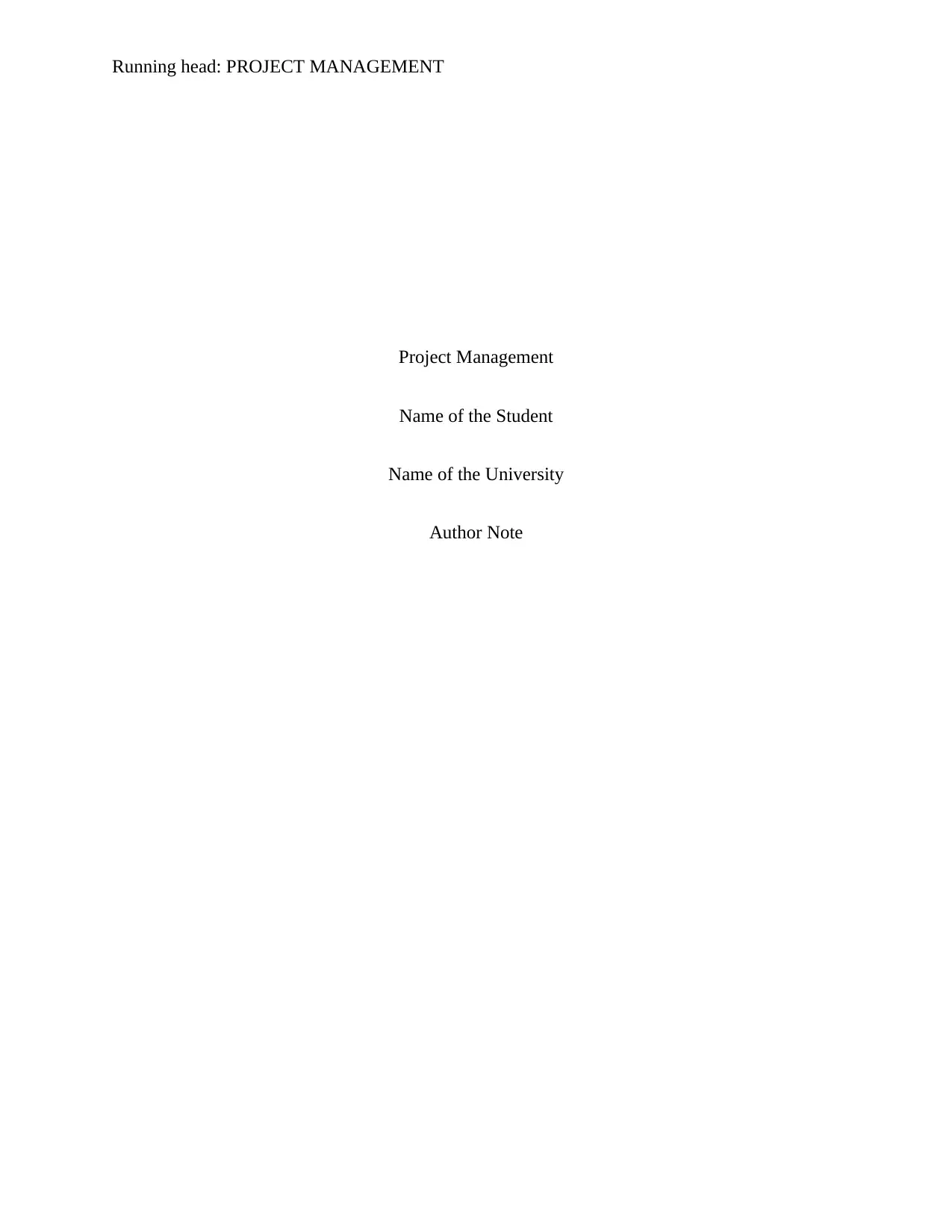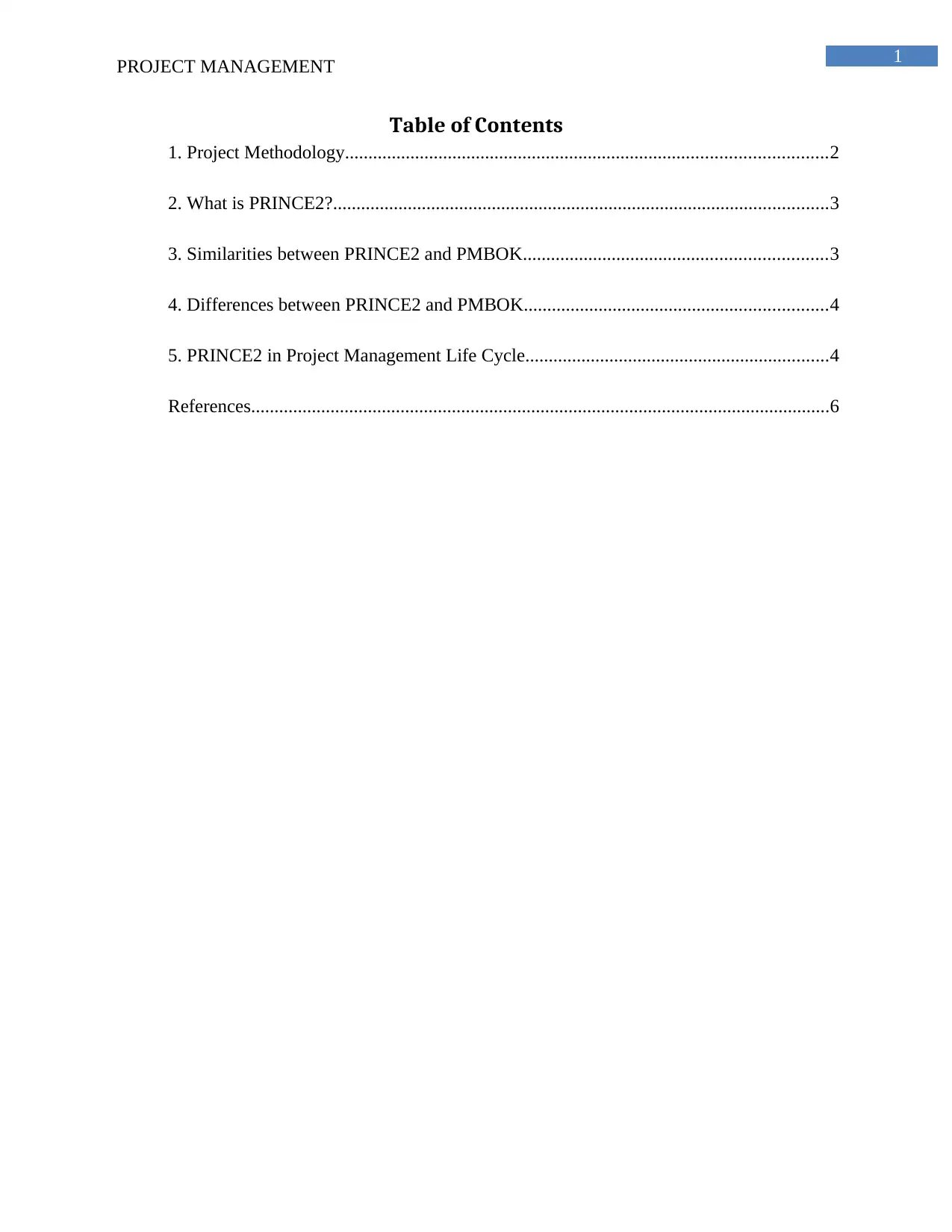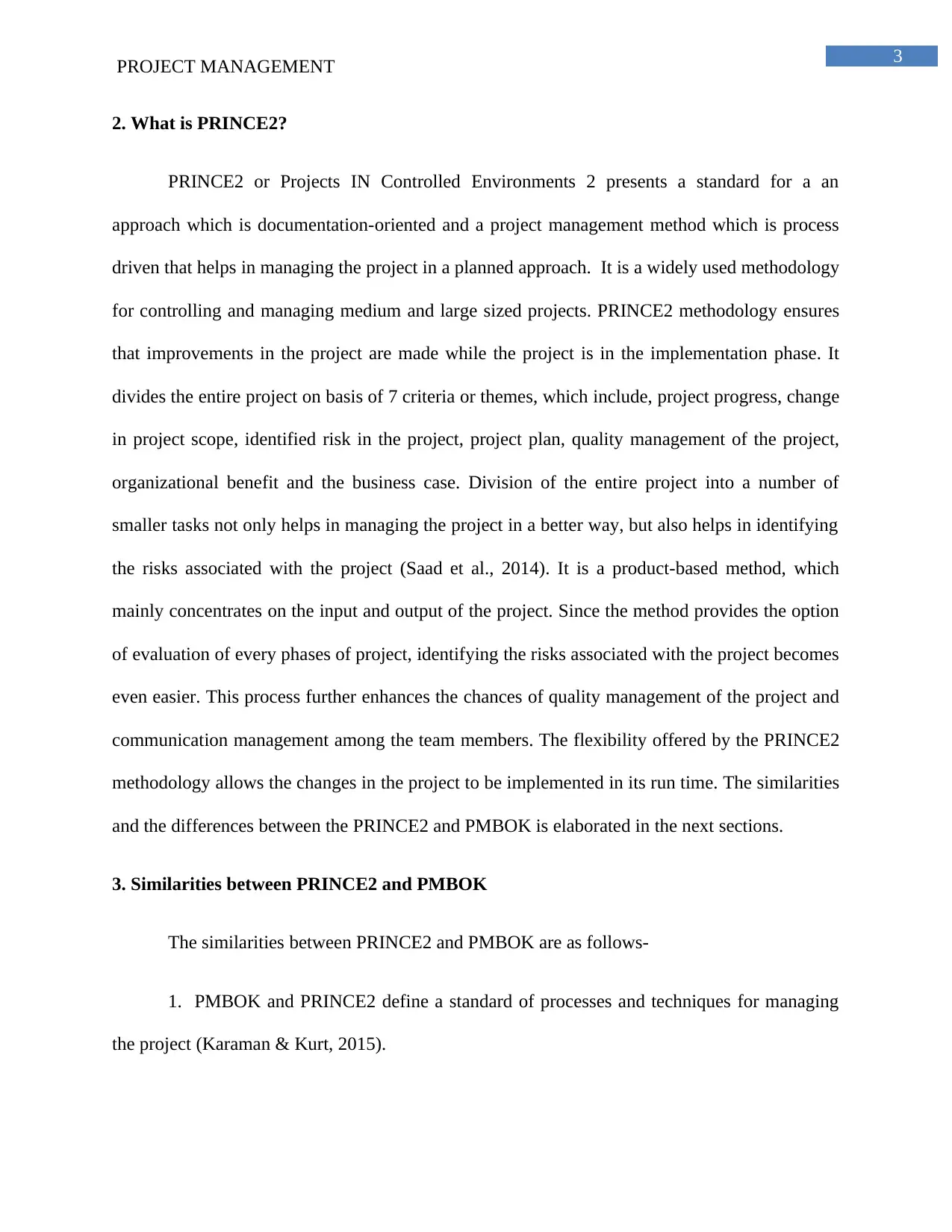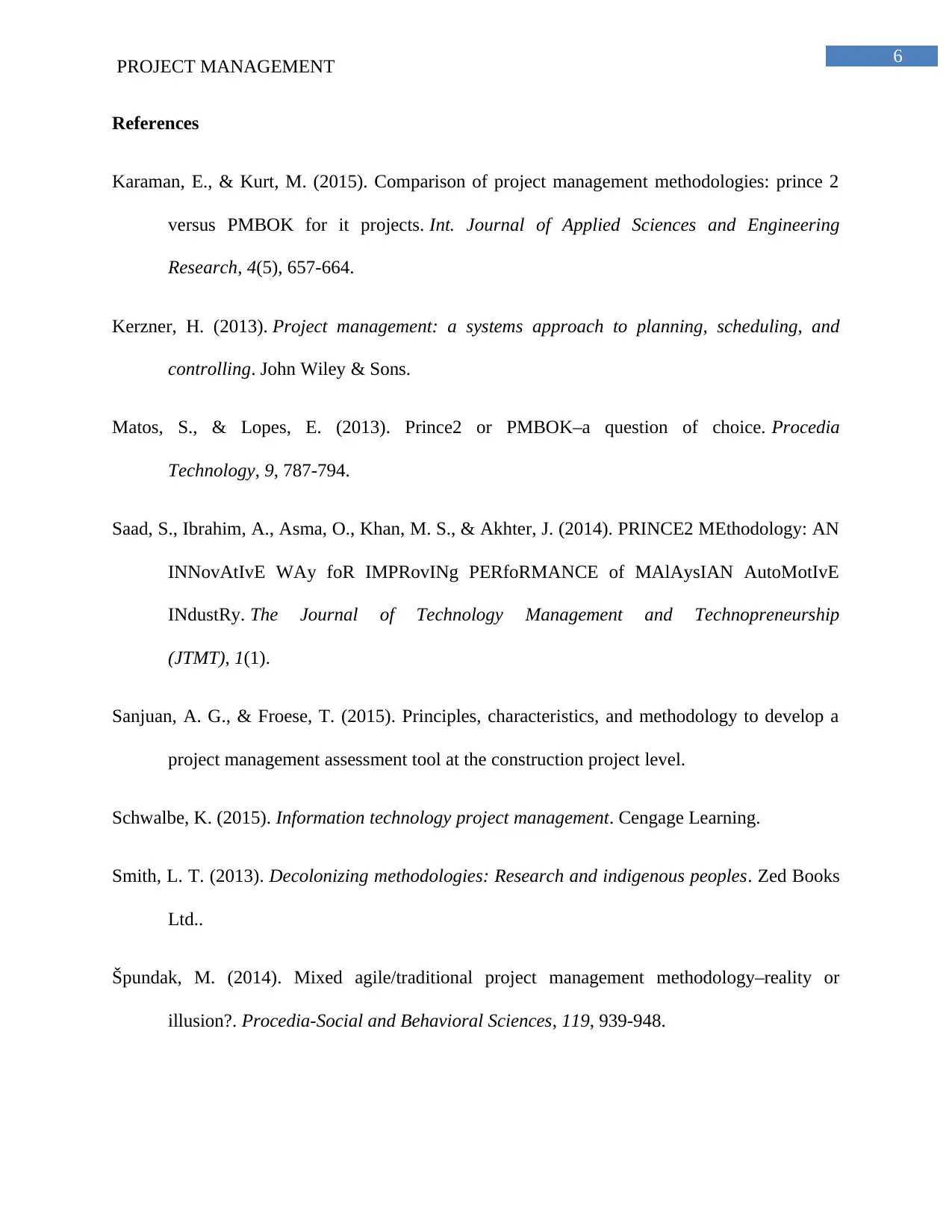Exploring PRINCE2 and PMBOK: A Comparative Study of Methodologies
VerifiedAdded on 2023/06/15
|8
|1395
|204
Report
AI Summary
This report provides a detailed comparison of PRINCE2 (Projects IN Controlled Environments 2) and PMBOK (Project Management Body of Knowledge) methodologies in project management. It begins by defining project methodology and its importance in ensuring project success. The report then introduces PRINCE2, highlighting its process-driven and documentation-oriented approach, emphasizing its seven themes for managing projects effectively. The similarities between PRINCE2 and PMBOK are outlined, focusing on their shared emphasis on risk management, resource allocation, and project monitoring. The report also details the key differences between the two methodologies, such as PRINCE2's detailed business case versus PMBOK's stronger focus on roles, responsibilities, and stakeholder management. Finally, it discusses the application of PRINCE2 throughout the project management life cycle, emphasizing its process-based approach and the roles of project board members and project managers in ensuring effective project management. This document is available on Desklib, a platform providing study tools for students.

Running head: PROJECT MANAGEMENT
Project Management
Name of the Student
Name of the University
Author Note
Project Management
Name of the Student
Name of the University
Author Note
Paraphrase This Document
Need a fresh take? Get an instant paraphrase of this document with our AI Paraphraser

1
PROJECT MANAGEMENT
Table of Contents
1. Project Methodology.......................................................................................................2
2. What is PRINCE2?..........................................................................................................3
3. Similarities between PRINCE2 and PMBOK.................................................................3
4. Differences between PRINCE2 and PMBOK.................................................................4
5. PRINCE2 in Project Management Life Cycle.................................................................4
References............................................................................................................................6
PROJECT MANAGEMENT
Table of Contents
1. Project Methodology.......................................................................................................2
2. What is PRINCE2?..........................................................................................................3
3. Similarities between PRINCE2 and PMBOK.................................................................3
4. Differences between PRINCE2 and PMBOK.................................................................4
5. PRINCE2 in Project Management Life Cycle.................................................................4
References............................................................................................................................6

2
PROJECT MANAGEMENT
1. Project Methodology
Project methodology can be termed as a intelligent combination of logically related
processes, practices and methods, which is helps in determining the best plan and control to
develop and deliver a project by implementing it in an effective manner. The purpose of the
project methodology is to allow proper control to the entire project in order to ensure the success
of the project. It defines the approaches, techniques, methods and technologies that is adapted for
successful completion of a project. A project methodology provides the structure or the skeleton
for describing the every stages of project management in depth by properly analyzing the project
requirements. The project manager appointed for a project is responsible for identifying a proper
methodology for implementing the project according to the budget, schedule and the
specifications given by the client. A proper methodology helps in identifying and defining the
needs of the stakeholders, estimating the cost of the project and resolving the conflicts that may
arise while implementing the project (Špundak 2014).
Project management consists of varieties of methods, which are employed for managing
the different project types. The project methodologies can be broadly divided into two parts, the
traditional and the modern approaches (Smith, 2013). The traditional project management
methodology consist of pre defined phases such as project initiation, project planning and design,
project execution, project control and integration, project validation and project closure
(Schwalbe, 2015). The modern project management methodologies include PMBOK, PRINCE2,
Six Sigma, XP, scrum agile and so on. There are a number of similarities in PMBOK and
PRINCE2 in terms of the project management approach both the methodology employ for
managing a project (Kerzner, 2013).
PROJECT MANAGEMENT
1. Project Methodology
Project methodology can be termed as a intelligent combination of logically related
processes, practices and methods, which is helps in determining the best plan and control to
develop and deliver a project by implementing it in an effective manner. The purpose of the
project methodology is to allow proper control to the entire project in order to ensure the success
of the project. It defines the approaches, techniques, methods and technologies that is adapted for
successful completion of a project. A project methodology provides the structure or the skeleton
for describing the every stages of project management in depth by properly analyzing the project
requirements. The project manager appointed for a project is responsible for identifying a proper
methodology for implementing the project according to the budget, schedule and the
specifications given by the client. A proper methodology helps in identifying and defining the
needs of the stakeholders, estimating the cost of the project and resolving the conflicts that may
arise while implementing the project (Špundak 2014).
Project management consists of varieties of methods, which are employed for managing
the different project types. The project methodologies can be broadly divided into two parts, the
traditional and the modern approaches (Smith, 2013). The traditional project management
methodology consist of pre defined phases such as project initiation, project planning and design,
project execution, project control and integration, project validation and project closure
(Schwalbe, 2015). The modern project management methodologies include PMBOK, PRINCE2,
Six Sigma, XP, scrum agile and so on. There are a number of similarities in PMBOK and
PRINCE2 in terms of the project management approach both the methodology employ for
managing a project (Kerzner, 2013).
⊘ This is a preview!⊘
Do you want full access?
Subscribe today to unlock all pages.

Trusted by 1+ million students worldwide

3
PROJECT MANAGEMENT
2. What is PRINCE2?
PRINCE2 or Projects IN Controlled Environments 2 presents a standard for a an
approach which is documentation-oriented and a project management method which is process
driven that helps in managing the project in a planned approach. It is a widely used methodology
for controlling and managing medium and large sized projects. PRINCE2 methodology ensures
that improvements in the project are made while the project is in the implementation phase. It
divides the entire project on basis of 7 criteria or themes, which include, project progress, change
in project scope, identified risk in the project, project plan, quality management of the project,
organizational benefit and the business case. Division of the entire project into a number of
smaller tasks not only helps in managing the project in a better way, but also helps in identifying
the risks associated with the project (Saad et al., 2014). It is a product-based method, which
mainly concentrates on the input and output of the project. Since the method provides the option
of evaluation of every phases of project, identifying the risks associated with the project becomes
even easier. This process further enhances the chances of quality management of the project and
communication management among the team members. The flexibility offered by the PRINCE2
methodology allows the changes in the project to be implemented in its run time. The similarities
and the differences between the PRINCE2 and PMBOK is elaborated in the next sections.
3. Similarities between PRINCE2 and PMBOK
The similarities between PRINCE2 and PMBOK are as follows-
1. PMBOK and PRINCE2 define a standard of processes and techniques for managing
the project (Karaman & Kurt, 2015).
PROJECT MANAGEMENT
2. What is PRINCE2?
PRINCE2 or Projects IN Controlled Environments 2 presents a standard for a an
approach which is documentation-oriented and a project management method which is process
driven that helps in managing the project in a planned approach. It is a widely used methodology
for controlling and managing medium and large sized projects. PRINCE2 methodology ensures
that improvements in the project are made while the project is in the implementation phase. It
divides the entire project on basis of 7 criteria or themes, which include, project progress, change
in project scope, identified risk in the project, project plan, quality management of the project,
organizational benefit and the business case. Division of the entire project into a number of
smaller tasks not only helps in managing the project in a better way, but also helps in identifying
the risks associated with the project (Saad et al., 2014). It is a product-based method, which
mainly concentrates on the input and output of the project. Since the method provides the option
of evaluation of every phases of project, identifying the risks associated with the project becomes
even easier. This process further enhances the chances of quality management of the project and
communication management among the team members. The flexibility offered by the PRINCE2
methodology allows the changes in the project to be implemented in its run time. The similarities
and the differences between the PRINCE2 and PMBOK is elaborated in the next sections.
3. Similarities between PRINCE2 and PMBOK
The similarities between PRINCE2 and PMBOK are as follows-
1. PMBOK and PRINCE2 define a standard of processes and techniques for managing
the project (Karaman & Kurt, 2015).
Paraphrase This Document
Need a fresh take? Get an instant paraphrase of this document with our AI Paraphraser

4
PROJECT MANAGEMENT
2. Both PMBOK and PRINCE2 ensure that the project risks are identified and eliminated
while the project is being implemented. It accelerates the change and ensures availability of
resources throughout the project implementation.
3. Both the methodologies ensures that the project is properly monitored throughout the
project execution phase and thereby reduces the risks of unsatisfactory deliverable, over
spending and resource slippage (Sanjuan & Froese, 2015).
4. Differences between PRINCE2 and PMBOK
The differences between the PRINCE2 methodology and PMBOK are as follows-
1. PRINCE2 has 7 themes that defines the aspects that a project manager should address
in order to implement the project successfully. On the other hand, PMBOK deals with 10
knowledge areas that define a proper set of processes and activities that constitutes the
professional field of project management.
2. PRINCE2 defines the business case in detail, while PMBOK does not define it in
detail. PMBOK however has stronger mechanism for defining the roles, responsibilities and
human resource management.
3. The concept and process of stakeholder management is stronger in PMBOK as
PRINCE2 partly covers this part. Furthermore, the integration knowledge area is not covered by
PRINCE2 while PMBOK offers a complete set of it (Matos & Lopes, 2013).
5. PRINCE2 in Project Management Life Cycle
PRINCE2 is a process-based approach of project management that focuses on the
controls and organization has on an ongoing project. The PRINCE2 method is built on 7
PROJECT MANAGEMENT
2. Both PMBOK and PRINCE2 ensure that the project risks are identified and eliminated
while the project is being implemented. It accelerates the change and ensures availability of
resources throughout the project implementation.
3. Both the methodologies ensures that the project is properly monitored throughout the
project execution phase and thereby reduces the risks of unsatisfactory deliverable, over
spending and resource slippage (Sanjuan & Froese, 2015).
4. Differences between PRINCE2 and PMBOK
The differences between the PRINCE2 methodology and PMBOK are as follows-
1. PRINCE2 has 7 themes that defines the aspects that a project manager should address
in order to implement the project successfully. On the other hand, PMBOK deals with 10
knowledge areas that define a proper set of processes and activities that constitutes the
professional field of project management.
2. PRINCE2 defines the business case in detail, while PMBOK does not define it in
detail. PMBOK however has stronger mechanism for defining the roles, responsibilities and
human resource management.
3. The concept and process of stakeholder management is stronger in PMBOK as
PRINCE2 partly covers this part. Furthermore, the integration knowledge area is not covered by
PRINCE2 while PMBOK offers a complete set of it (Matos & Lopes, 2013).
5. PRINCE2 in Project Management Life Cycle
PRINCE2 is a process-based approach of project management that focuses on the
controls and organization has on an ongoing project. The PRINCE2 method is built on 7

5
PROJECT MANAGEMENT
principals that is followed throughout the project management life cycle. This helps the team to
work in a coordinated manner as the project reports are sought and recorded at every stage of
project management that helps in improving the implementation process as well. In this
methodology, the roles and responsibility of the team members are clearly defined that further
helps in implementing the project in a planned manner. The project board members play a
significant role in managing the progress of the project. The project board members are
responsible for establishing the baseline requirements of the project such as time, cost, risk and
scope of the project. The project manager is responsible for monitoring the project progress and
reports it to the board members (Tomanek & Juricek, 2015). Therefore, PRINCE2 helps in
proper and effective project management.
PROJECT MANAGEMENT
principals that is followed throughout the project management life cycle. This helps the team to
work in a coordinated manner as the project reports are sought and recorded at every stage of
project management that helps in improving the implementation process as well. In this
methodology, the roles and responsibility of the team members are clearly defined that further
helps in implementing the project in a planned manner. The project board members play a
significant role in managing the progress of the project. The project board members are
responsible for establishing the baseline requirements of the project such as time, cost, risk and
scope of the project. The project manager is responsible for monitoring the project progress and
reports it to the board members (Tomanek & Juricek, 2015). Therefore, PRINCE2 helps in
proper and effective project management.
⊘ This is a preview!⊘
Do you want full access?
Subscribe today to unlock all pages.

Trusted by 1+ million students worldwide

6
PROJECT MANAGEMENT
References
Karaman, E., & Kurt, M. (2015). Comparison of project management methodologies: prince 2
versus PMBOK for it projects. Int. Journal of Applied Sciences and Engineering
Research, 4(5), 657-664.
Kerzner, H. (2013). Project management: a systems approach to planning, scheduling, and
controlling. John Wiley & Sons.
Matos, S., & Lopes, E. (2013). Prince2 or PMBOK–a question of choice. Procedia
Technology, 9, 787-794.
Saad, S., Ibrahim, A., Asma, O., Khan, M. S., & Akhter, J. (2014). PRINCE2 MEthodology: AN
INNovAtIvE WAy foR IMPRovINg PERfoRMANCE of MAlAysIAN AutoMotIvE
INdustRy. The Journal of Technology Management and Technopreneurship
(JTMT), 1(1).
Sanjuan, A. G., & Froese, T. (2015). Principles, characteristics, and methodology to develop a
project management assessment tool at the construction project level.
Schwalbe, K. (2015). Information technology project management. Cengage Learning.
Smith, L. T. (2013). Decolonizing methodologies: Research and indigenous peoples. Zed Books
Ltd..
Špundak, M. (2014). Mixed agile/traditional project management methodology–reality or
illusion?. Procedia-Social and Behavioral Sciences, 119, 939-948.
PROJECT MANAGEMENT
References
Karaman, E., & Kurt, M. (2015). Comparison of project management methodologies: prince 2
versus PMBOK for it projects. Int. Journal of Applied Sciences and Engineering
Research, 4(5), 657-664.
Kerzner, H. (2013). Project management: a systems approach to planning, scheduling, and
controlling. John Wiley & Sons.
Matos, S., & Lopes, E. (2013). Prince2 or PMBOK–a question of choice. Procedia
Technology, 9, 787-794.
Saad, S., Ibrahim, A., Asma, O., Khan, M. S., & Akhter, J. (2014). PRINCE2 MEthodology: AN
INNovAtIvE WAy foR IMPRovINg PERfoRMANCE of MAlAysIAN AutoMotIvE
INdustRy. The Journal of Technology Management and Technopreneurship
(JTMT), 1(1).
Sanjuan, A. G., & Froese, T. (2015). Principles, characteristics, and methodology to develop a
project management assessment tool at the construction project level.
Schwalbe, K. (2015). Information technology project management. Cengage Learning.
Smith, L. T. (2013). Decolonizing methodologies: Research and indigenous peoples. Zed Books
Ltd..
Špundak, M. (2014). Mixed agile/traditional project management methodology–reality or
illusion?. Procedia-Social and Behavioral Sciences, 119, 939-948.
Paraphrase This Document
Need a fresh take? Get an instant paraphrase of this document with our AI Paraphraser

7
PROJECT MANAGEMENT
Tomanek, M., & Juricek, J. (2015). Project risk management model based on PRINCE2 and
SCRUM frameworks. arXiv preprint arXiv:1502.03595.
PROJECT MANAGEMENT
Tomanek, M., & Juricek, J. (2015). Project risk management model based on PRINCE2 and
SCRUM frameworks. arXiv preprint arXiv:1502.03595.
1 out of 8
Related Documents
Your All-in-One AI-Powered Toolkit for Academic Success.
+13062052269
info@desklib.com
Available 24*7 on WhatsApp / Email
![[object Object]](/_next/static/media/star-bottom.7253800d.svg)
Unlock your academic potential
Copyright © 2020–2025 A2Z Services. All Rights Reserved. Developed and managed by ZUCOL.



